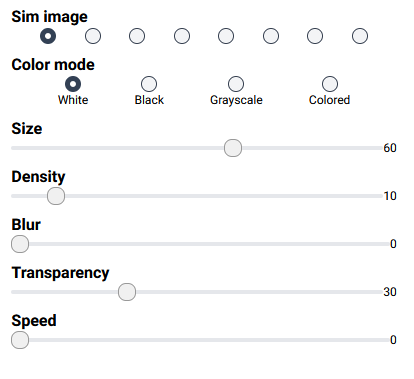Sim parameters
The parameter names should be self-explanatory, so this page mostly provides specific hints that are important for making adjustments.
While adjusting the parameters, the cursor keys and the mouse wheel can be used to navigate through the parameters and change their values. This allows to keep the focus on the images. The parameters are listed in the recommended order of initial adjustment. Thereafter, they should be revisited in arbitrary order to optimize the adjustments.

Sim image: If the adjustments differ across images, it is important to maintain consistency between the selected image and its adjustments when exiting the simulator to save the parameters.
Color mode: The color mode may vary depending on the background; in such cases, the most prominent color mode should be selected.
Size: The dot size is the most difficult parameter to adjust because it must not match the size of the subjectively perceived visual snow but should be adjusted to a 3-fold version of it, in accordance with the zoom concept. This is the only parameter that scales up!
Density: Density corresponds to the number of dots. The number of visual snow dots in the small image should match the number of physically displayed dots in the big image. For example, if 50 VS dots are perceived in the small image, 50 scaled-up dots should be displayed in the big image.
Blur: This parameter determines how soft (or sharp) the edges of the dots appear relative to the dot size.
Transparency: Transparency is the extent to which the background can be seen through the dots.
Speed: Speed refers to the timing of dot flickering. By default, this parameter is set to zero, indicating no flickering, because flickering dots can alter the apparent dot density (e.g., due to palinopsia - afterimages or trailing, which is a common symptom in VS patients). Therefore, speed should be adjusted last. If other parameters are revisited, the speed should be set back to zero.
